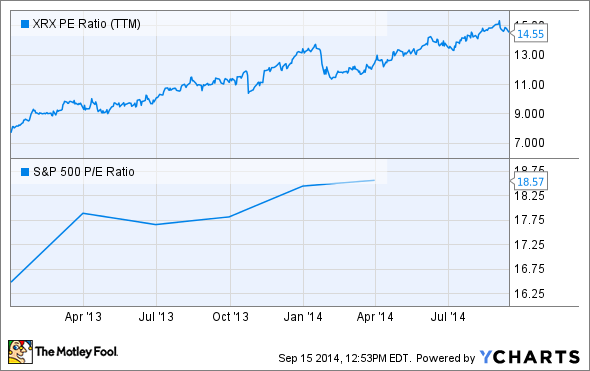After decades of sub-par performance, Xerox (XRX) has given investors a pleasant surprise over the past year as its shares have risen roughly 30%. Yet Wall Street's analysts have been unimpressed lately, as more rate the stock a Hold than a Buy, with two analysts downgrading it to that status in the past year alone. Are they wrong? I recently took a look at several reasons why Xerox might be on its way up, but it's important to consider both sides of the coin before diving into a stock. Today, we'll take a look at a few reasons why Xerox's strong performance might soon come to an end.
Nearly all of Xerox's growth is due to higher valuations
Since the start of 2013, Xerox's shares have nearly doubled. However, its P/E ratio has grown by nearly the same rate, and its price-to-free-cash-flow ratio has been close behind:
This situation is hardly unique to Xerox, as many of its peers on the S&P 500 (SNPINDEX: ^GSPC) have seen shares soar largely because of investor optimism rather than because earnings have been on the upswing. However, most S&P 500 companies have put together solid earnings growth, as the aggregate EPS growth rate for all 500 companies is nearly 17% since the start of 2013. Underperforming the index on a fundamental basis is not likely to result in long-term share-price outperformance. Xerox does have low valuations in its favor, as its P/E ratio is currently 22% lower than the overall S&P 500. But if its shares continue to grow without a corresponding growth in earnings, that will soon change -- Xerox's P/E has nearly doubled since the start of 2013, but the S&P's is up by a mere 13%.
XRX P/E Ratio (TTM) data by YCharts
Margins are shrinking in Xerox's services segment
As I pointed out in a more bullish review, Xerox has successfully transitioned from a hardware-focused company to one that generates most of its revenue from services. However, the services segment has endured dwindling margins over the past several years, to the point where its margins are notably weaker than the shrinking hardware segment:
|
Year |
Technology Segment Margin |
Services Segment Margin |
|---|---|---|
|
2010 |
10.5% |
11.7% |
|
2011 |
11.1% |
11.1% |
|
2012 |
11.3% |
10.2% |
|
2013 |
10.8% |
9.8% |
Sources: Xerox annual reports.
Xerox executives have warned that margins will likely be weaker for the near term, a problem they've blamed recently on sales in the government health care business, which has been problematic on a profit basis for many companies serving this gargantuan sector of the American economy. Xerox expects its services margins to creep back toward double digits soon, but its full-year margin guidance range of 9.4% to 9.8% for the services segment looks to continue a multiyear slide.
If revenues in the company's technology segment continue to decline at mid-single-digit rates (revenue was down 1% in 2011, 8% in 2012, and 6% in 2013), services could very well account for two-thirds of total revenue by 2017, as projected. However, subpar margins could depress earnings growth for some time -- analysts anticipate EPS growth of just 1.8% this year, which will rise to 8% next year. An 8% uptick is solid, but well below the IT service sector's overall expected growth rate of 33.8%. Xerox is striving to emulate IBM's (IBM -0.89%) successful transition from hardware to services, but it's got a long way to go to catch up to Big Blue's margins:
XRX Profit Margin (TTM) data by YCharts
Xerox is becoming increasingly reliant on government contracts
Xerox has taken on a large number of government contracts as it transitions toward becoming a fully services-focused company. Providing services to governmental healthcare organizations now accounts for 7% of overall revenue, and the loss of any one contract can have an outsized impact on company momentum. In its latest quarter, Xerox lost a contract to provide services for Texas' Medicaid agency, and this one deal was equivalent to roughly 1.5% of total revenue, according to Nelson Hall analyst Rachael Stormonth.
Xerox doesn't break out what percentage of revenue comes from government sources, but its 10-K admits that "a significant portion of ... revenues are derived from contracts with U.S. federal, state, and local governments and their agencies, as well as international governments and their agencies." As the U.S. and many other governments continue a prolonged bout of belt-tightening, many companies that have relied on government spending have found themselves grappling with declining revenues. Four of the five largest government contractors by revenue rely almost exclusively on Uncle Sam's checkbook, and over the past five years only one of them has managed to boost its top line higher:
LMT Revenue (TTM) data by YCharts
Xerox isn't quite in the same boat as these military-focused contractors, and its emphasis on healthcare services is no doubt a good move to capitalize on a country with a new universal health-insurance mandate that's simultaneously grappling with a rising tide of elderly residents. However, relying on government sources of revenue can nonetheless be risky if Xerox should find its services undercut or rendered superfluous by competitors or changes to the law.
Three good reasons?
Xerox's bears have not managed to swat down the stock's bullish charge just yet, but that doesn't mean that its good times will continue forever. These three problems could undo Xerox's gains, but only if the market decides that they pose a threat so grave that the company's strengths can't overcome them. Will these reasons be enough for you to stay away today, or does Xerox have too much in its favor to be kept down for the long term?









